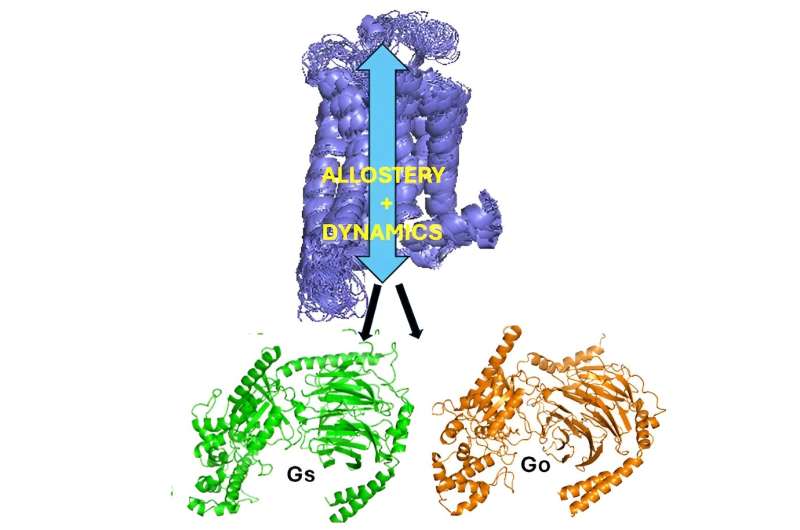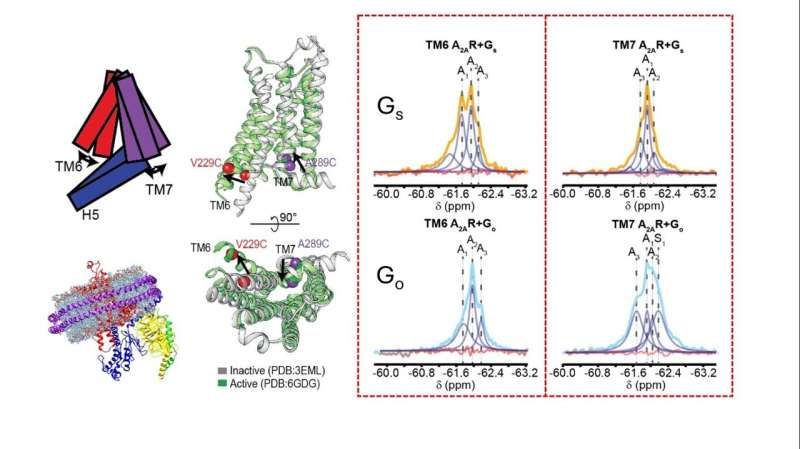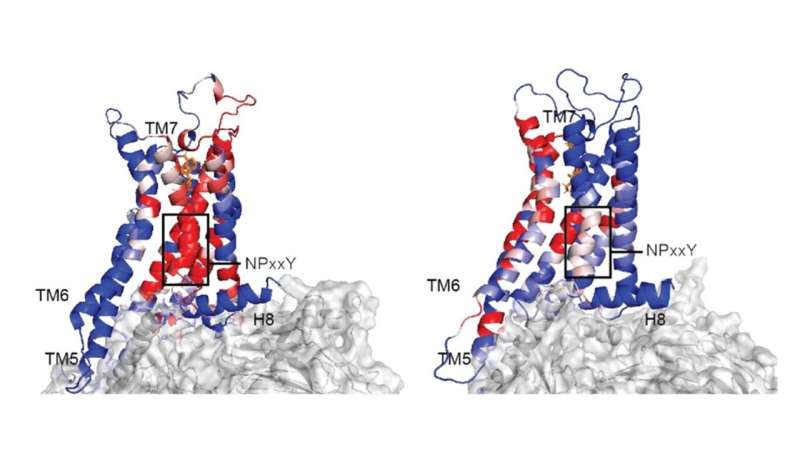This article has been reviewed according to Science X's editorial process and policies. Editors have highlighted the following attributes while ensuring the content's credibility:
fact-checked
peer-reviewed publication
trusted source
proofread
Researchers elucidate mechanisms behind protein selectivity in adenosine receptor

In a new study, a multinational research team led by Dr. Adnan Sljoka (RIKEN) and Prof. Akio Kitao (Tokyo Tech), in collaboration with Prof. Scott Prosser (University of Toronto), has carried out experimental and computational studies to elucidate the mechanisms behind G protein selectivity and efficacy in the human adenosine A2A receptor (A2AR).
A2AR is a member of major drug targets G protein-coupled receptor (GPCR) superfamily, which engages the G protein and initiates cell signaling, influencing heart health, inflammation, cancer, and brain diseases.
Scientists have made a breakthrough in understanding how A2AR can engage and activate multiple binding G-proteins and the mechanisms of this selective coupling. The work is published in Nature Chemical Biology.
The research team discovered that the hallmark coupling promiscuity in A2AR is a direct consequence of changes in activation conformations. Moreover, the long-range (allosteric) communication mechanisms elegantly control the sampling of specific conformers within a dynamic conformational ensemble.
This study offers profound insights into GPCRs selectivity and biased signaling. These findings are expected to have major implications in drug discovery and pave the way for novel GPCR-targeted therapeutic strategies in treating various human conditions, including cancer and neurogenerative disorders.
This research will also enable the design of more generalized computational and AI-driven studies, pushing the boundaries in GPCR activation mechanisms and next-generation pharmacology.
Background
GPCRs are the largest receptor class, affecting almost every aspect of human physiology, with 35% of all approved drugs acting on GPCRs. They regulate sensory and neuronal signaling, as well as a myriad of processes associated with cell homeostasis, growth, and immune response.
GPCRs are primarily situated in the plasma membrane surrounding the cell, while the drug or ligand (such as hormones and neurotransmitters) that acts on the GPCR binds to an extracellular pocket. Activation is then communicated across the receptor, resulting in complexation with proteins on the cell interior.
Since the signal arrives at the cell exterior and initiates signaling pathways within the cell, this makes GPCRs particularly useful in drug discovery, as the drug in many cases need not enter the cell.
However, GPCRs activation is related to dynamic events, key intermediate states, and activation states that arise between the time a ligand binds and when the G protein is activated. Furthermore, many GPCRs are promiscuous as they selectively interact with different G proteins, each influencing a unique cellular response. In fact, G protein selectivity is one of the least understood aspects of GPCR biology.
Capturing the conformational dynamics of GPCRs, describing various functional states, and understanding allosteric mechanisms and their role in G protein selectivity, coupling promiscuity, activation and signaling mechanisms is a formidable challenge, making it difficult to predict or control GPCR behavior in drug development.

Overview of the research
Using experimental and computational techniques, including functional assays, Fluorine-nuclear magnetic resonance (19F-NMR), mathematical rigidity theory, Molecular Dynamics Simulations and rigidity and geometry Monte Carlo simulations, the international research team discovered the mechanism behind GPCR-G protein selectivity.
The team focused their study on the human adenosine A2A receptor (A2AR). A2AR is a prototypical GPCR distributed in the nervous system, platelets, immune cells, lungs, heart, and vasculature, engaging several G proteins (notably, Go) in addition to its cognate Gs protein.
A2AR drugs have been developed to address wound healing, vascular diseases, including atherosclerosis, restenosis, and platelet activation, as well as inflammation and cancer. However, pharmacological regimens are thought to act exclusively as antagonists or agonists to the A2AR-Gs complex.
Thus, understanding the mechanism of G protein selectivity and efficacy in A2AR, and the general bias and activation mechanisms in GPCRs, can yield new opportunities in pharmacology.
The researchers focused on studying key conformational states and dynamics of A2AR by complexing it with both cognate Gs and non-cognate Go G-proteins with the same agonist ligand. 19F NMR revealed several functional activation states of A2AR when it is coupled to Gs and Go G-proteins.
When A2AR is engages with its preferred Gs partner, the receptor adapts long-lived and highly populated activation states. However, when coupled to Go, these activation conformational states are significantly less engaged and populated. In fact, one of the activation states was mainly observed when the receptor was engaged with Gs but not Go.
Molecular dynamics simulations and dPaCS-MD/MSM calculation, performed at Dr. Kitao lab, indicate that Gs forms more interactions with A2AR and has stronger binding affinity compared to Go. Additional Monte Carlo simulations performed by Dr. Tucs confirmed when A2AR engages Gs or Go G-proteins, there are major changes in the receptor's dynamics, which dictate the populations and interconversions between activation states identified through NMR. This led to the hypothesis that allostery (long range communication) might be at play.
To probe allostery in the receptor, the researchers utilized rigidity theory techniques developed by Dr. Sljoka. Rigidity theory analysis validated the presence of multiple adaptive allosteric networks which were distinct when the receptor engages with Gs and Go. The allosteric mechanisms directly control the dynamic differences and transitions between distinct functional states, playing a major role in G protein selectivity and G-protein-receptor coupling.
The ability of GPCRs to connect with multiple proteins through distinct activation states could lead to better treatments, highlighting the complex yet fascinating ways our body's cells communicate and respond to signals. The findings in this study offer important insights into GPCRs selectivity, allostery, partial agonism and biased signaling, with major implications in drug discovery.

Future developments
While the current study provides an unprecedented mechanistic understanding of coupling and promiscuity in A2AR, future studies will no doubt focus on trying to generalize to other GPCRs and incorporation of advanced AI models.
These efforts have significant implications for designing safer and more selective therapeutics targeting GPCRs and will deepen our overall understanding of cellular signaling mechanisms.
More information: Louis-Philippe Picard et al, Balancing G protein selectivity and efficacy in the adenosine A2A receptor, Nature Chemical Biology (2024). DOI: 10.1038/s41589-024-01682-6
Journal information: Nature Chemical Biology
Provided by Tokyo Institute of Technology



















